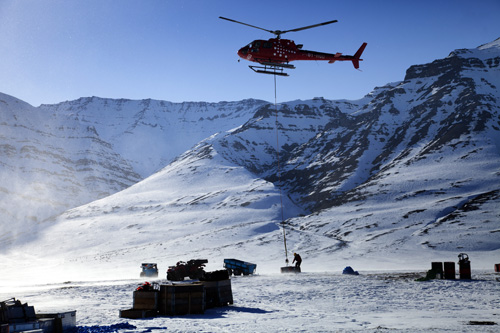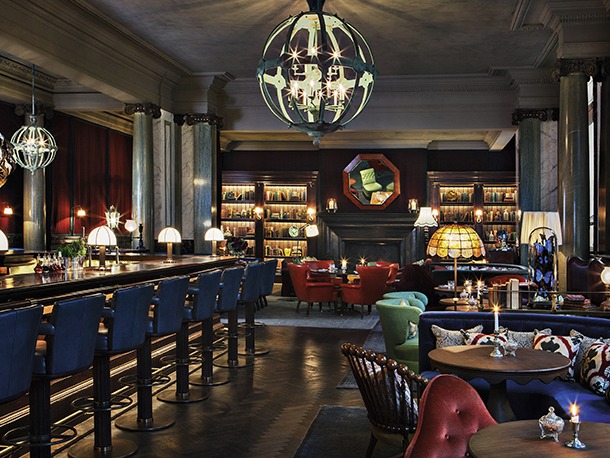
“There are a number of motivations for our company to be here in Greenland,” explains Nicholas Rose, Chief Executive Officer of Avannaa Resources, “the primary one being the geological map of the country that shows a large variety of geotectonic environments that have high potential for hosting giant ore deposits.”
Hailed as one of the next great frontiers for exploration Greenland possesses a massive geological endowment, with virtually every part of it showing signs of being prospective for some form of mineral or metal. Boasting a stable democracy and well-defined legal and administrative systems, Greenland is also an attractive destination as it currently lacks the level of exploration that other parts of the world with similar geological potential experience at present.
Founded by a group of British and Danish geologists in 2006, Avannaa Resources is focused exclusively on Greenland. Based in Copenhagen, Denmark, the company’s strategy is to act as a prospect generator, locating potential targets before conducting preliminary work to make the project attractive for potential joint venture partners.
Avannaa’s exploration strategy is based on applying quite stringent minimum criteria to any projects that are being considered at the generative stage. Prospects under consideration must have the potential to develop into very large mining projects based on major industrial commodities that can survive dips in price-cycles. These criteria point to the major infrastructure metals such as copper, nickel and zinc, and eliminate minor and specialty metals.
“There are definitely common threads that link our projects,” Rose continues, “the strongest being that we strive to identify targets that can yield big ore deposits with very robust economics.” Beginning its work with a strong geological model in place the company goes into the area in question with the aim of building up good targets that can subsequently be tested by drilling.
On initiating a new project Avannaa spends one to three years of preliminary investigation where the objective is to pinpoint drill targets, well constrained by geophysical surveys, remote sensing and surface geology including geochemical sampling and geological mapping.
“What also links the projects that we choose and generate,” Rose says, “is the way we approach each with a view to making them as interesting as possible to potential partners. What we do is examine the sort of targets these large companies want to explore and ask ourselves what sort of preliminary work do we need to do in order to make the project attractive and encourage partners to get down to the real business at hand, which is actually drilling targets.”
Avannaa currently has four priority projects with active work programmes where it is single-mindedly preparing to drill with the next couple of years. At present the company has option and joint venture agreements on two of its projects with Anglo American and Boliden.
Avannaa’s partnership with Anglo American covers its Jameson Land assets, which have potential for sedimentary hosted copper. The area contains many known copper and other base metal mineralisations found mainly in Permo-Triassic rocks. For its part Anglo American has the option to earn 55 percent interest in Avannaa’s existing exploration licence, as well as any additional properties that the parties choose to jointly explore within an Area of Interest comprising southern and central Jameson Land, and wholly outside of the National Park area, by expenditure of $15 million over a five year period. To date the East Greenland rocks, comprising approximately 2,500 square kilometres within the Area of Interest, remain under-explored.
Boliden on the other hand hold an option to earn 51 percent of the company’s Washington Land zinc licence. Prospective for carbonate-hosted zinc deposits, the licence contains a number of potential targets in carbonate platform sediments of the Franklinian Basin that covers much of northern Greenland and Canada, and hosts the historical Polaris mine. The licence area covers more than 6,000 square kilometres and contains several known mineralised zones that form parts of a regional fault system that remains under-explored.
In addition to the aforementioned assets, the company also owns two other projects where it is actively looking for partners and which illustrate its multi-pronged approach to drill targeting by applying several independent techniques. Both projects have an excellent geological basis and are situated close to tidal-water making them highly accessible in the happy outcome of developing to a large mining project.
The first of these is the Disko-Nuussuaq nickel-copper-PGE project. This project possesses all the elements necessary to provide a giant nickel-copper-PGE province of the Noril’sk type and its geological credentials have been well established by several decades of exploration that has included historical programs by Cominco and Falconbridge.
The second is the company’s Kangerluarsuk zinc project, located in a classic geological setting for giant SEDEX type deposits close to a margin between a shallow carbonate dominated platform and a deeper oceanic basin; other examples include the Selwyn Basin in the Yukon and the famous Rammelsberg mine in Northern Germany.
“The projects that we are engaged in,” Rose enthuses, “have the potential to help transform the economy of Greenland in ten to 15 years’ time. The role of mining companies in society is a much discussed point right now worldwide as well as in Greenland. There is a right time for everything and now it is the right time for us to focus on discovery and realise that distraction from that single aim is not beneficial for us or any of our stakeholders including the society within which we operate.”
It goes without saying that everyone within the exploration industry would like to see at least one project in Greenland becoming established as a successful on-going mining operation. While this is a development that is destined to happen sooner rather than later, the critical thing to achieve in the short term is to get as much exploration investment into the country as possible, because, as Rose highlights, the real potential for Greenland is still in the ground waiting to be found.
“There are a number of advanced projects that are at the feasibility stage now and practically all of them involve deposits that have been known about for decades,” Rose says. “What is needed now is a second and third wave of really strong projects, which are still at the early post-discovery stage or are still waiting to be found. That is what I believe will really help put Greenland on the map.”
For Avannaa the immediate objective is for the company to consolidate the partnerships it already has in place, while at the same time work on securing an investor or partner for its Disko-Nuussuaq and Kangerluarsuk projects. “Our aim is to get investment into these two strong projects within the next year so that we can drill them within the next two years,” Rose concludes. This model we have of prospect generation is quite sustainable in that we are always bringing new projects into the pipeline and we will continue to try to build our reputation and make ourselves attractive for future partnerships as Greenland itself develops in the years to come.”
Written by Will Daynes, research by Richard Halfhide



 AvannaaResources-Greenland-SPR-Bro-s.pdf
AvannaaResources-Greenland-SPR-Bro-s.pdf









